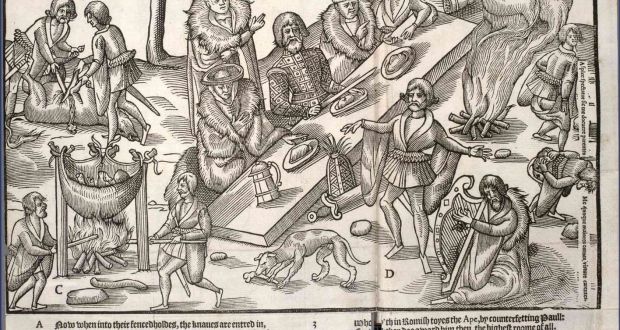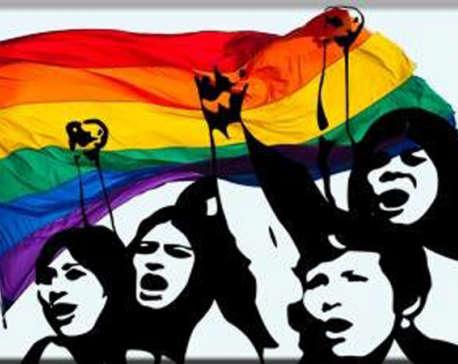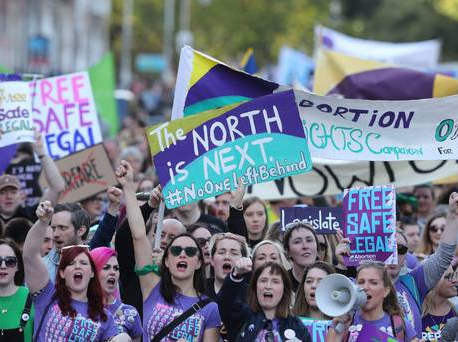
OR
Poets, patrons and homosexuality in medieval Ireland
Published On: August 20, 2018 02:30 PM NPT By: Agencies

In recent years, Irish society has undergone sweeping transformations, including legalisation of same-sex marriage and decriminalisation of homosexuality. It may come as a surprise to learn that in late medieval/early modern Ireland a cult of male homosexuality/bisexuality was apparently not only prevalent but widely tolerated among the upper echelons of Gaelic society, particularly the literati, but including also native kings and chieftains. Evidence of such tolerance is to be found especially in Gaelic Irish poetry of medieval and early modern date. However, scholars seem, for whatever reason, either to ignore, play down or deny this.
The cult seems rooted in the notion of the poet’s relationship with his royal or chiefly patron being equivalent to a marriage, the two sharing the same bed. The following English translations from the original Irish may be cited.
One poet tells his patron that it is no act of adultery towards his wife to “lie with me and my kind”, while another who has fallen out of favour seeks reconciliation by urging: “Let us not refrain any longer from lying on one couch, O fair one.” A 14th-century poet calls on his patron to “proffer your red lips to me, give me a fervent kiss . . .” The same states: “To him [the poet] is due loving favour, the primest [sic] liberality, precedence in counsel, the king’s counsel, the sharing of his bed . . .” Some of the language employed is even more extravagant. Thus, an elegy by Brian Ó Gnímh over the spiked head of Alasdair Mac Donald (1586) runs: “I love the still-unbleached red mouth/Head of silk complexion . . ./ . . . smooth delicate cheek/ . . . fine soft abundant curling tresses/ . . . gaze-holding green eyes . . ./ . . . perfect tresses”.
However, we are cautioned by Prof Pádraig Breatnach that “the guise of ‘spouse’ could be adopted by a poet towards several patrons at once”. The poet’s “full assumption of a feminine role” occurs within terms of an established literary “conceit”, and “we must be wary of drawing hasty conclusions as to his psychology...” A parallel study by Prof Katherine Simms draws attention to the contemporary “traditional role of the poet as in some sense his patron’s spouse or lover”. However, “the bard has no intention . . . of implying a homosexual relationship with his patron . . . Bed-sharing was a general mark of esteem and trust in this society, peculiarly appropriate between a king and his poet.” Both the foregoing base their observations in large part on the earlier work of Prof James Carney.
Lyrical conceit
However, to see the references cited above as amounting merely to poetic conceit or convention seems unrealistic. From a psychological standpoint it seems unlikely that a heterosexual male, even of poetic caste, would have possessed either the ability or inclination to adopt the role of homosexual lover, or been capable of sustaining it. The likelihood is that those giving expression to homoerotic sentiment were naturally so inclined. In the final analysis, if something quacks, waddles, has webbed feet and is partial to water, then it seems reasonable to conclude it is a duck. Presumably the role of the king or chieftain has to be seen in the same light. At the very least he must have been complicit – a demonstration, perhaps, of the power exercised by poets within Gaelic Irish society.
It seems unlikely a heterosexual male, even of poetic caste, would have possessed either the ability or inclination to adopt the role of homosexual lover, or been capable of sustaining it
Homoerotic sentiment apparently survived among the Gaelic Irish literati until well into the 17th century. We know, for instance, that the Kerry poet Piaras Feiritéar (1600-1653) one of the greatest Irish language poets of his day, composed both homoerotic and heterosexual verse. Evidence of the syndrome is earlier to be found in the case of a follower of Domhnall Cam Ó Súilleabháin Béara, hero of resistance to the forces of Elizabeth 1 in the early 1600s. The man concerned, John Anias, was captured by the English and executed. On the day before his death, given as November 8th, 1602, he sent a letter to Mac Muiris Chiarraí (Fitzmaurice Kerry) Baron of Lixnaw, signed: “Your loving bedfellow sometimes . . .” While, as already noted, bed-sharing was regarded as a privilege enjoyed by distinguished followers as well as poets of kings and chieftains, the denial by commentators that it had any homosexual connotations is not convincing. In the case just cited, for instance, one cannot but wonder what constituted a loving (as opposed to an unloving) bedfellow.
Spiritual bailiwick
One wonders about the domestic arrangements which such practices must have necessitated. Presumably all royal or chiefly rulers kept a resident chaplain who cannot but have been aware of the trysts – clearly illicit under church law – taking place nightly within his spiritual bailiwick. He would, in any case, have known of them from the relevant verses of the poets. Although it beggars belief to think that both priest and poet may, so to speak, have been actively jockeying for a place on the most prestigious pallet in the household, it seems clear that the Catholic clergy must have been prepared to tolerate the practices involved. Given recent revelations concerning the sexual transgressions of some of the latter in our own day nothing, perhaps, should astonish us.
One cannot but wonder also how the lady of the ruler, whether royal or chiefly, fitted into such a scheme of things. Even in an age long predating the emergence of feminist mores, her natural instinct would surely have resented what to us would seem her rightful place being usurped by male interlopers, poetic or otherwise. However, contemporaries were probably accustomed to a brisk turnover, so to speak, of sexual partners, both male and female. No doubt the lady on occasion secured private access to her lord’s bed – thereby reaffirming the sexual prowess (if not also versatility) of the latter, as perhaps befitted a great warrior. In such a society, however, the status of women even of genteel background must have been relatively low.
One cannot but wonder how the lady of the ruler, whether royal or chiefly, fitted into such a scheme of things
Unfortunately, we are not in a position to compare and contrast Gaelic Irish mores in the foregoing respects with those which may have prevailed at the same period in other parts of continental Europe. We do know that William Rufus, son of the Norman Duke William, conqueror of England in 1066, was very probably homosexual. By contrast with Gaelic Irish attitudes it would seem that the contemporary Anglo-Saxon chronicles refer to his activities in this regard with “reticence and horror”. The 17th-century Scottish king, James V1, who became James 1 of England, was also, apparently, predominantly homosexual, though what mark (if any) his proclivities left on English or Scottish records is not known to us. It would seem, in any case, that the subject merits more erudite, informed and broad investigation than the inadequate and superficial one presented here.
‘Confidential companion’
In the Beara peninsula in the early 18th century, we encounter what may be an echo of attitudes of the earlier bardic and other literary exponents of the syndrome. This comes across in particular in a powerful and moving marbhna composed by Domhnall Ó Conaill of Iveragh for Murtaí Óg Ó Súilleabháin of Eyeries, Castletownbere, Co Cork – a captain, according to tradition, in Lord Clare’s regiment of the Irish Brigade – who was surprised and killed in his home by a detachment of the Cork city garrison in May 1754. Ó Conaill (described as Murtaí’s manservant and “confidential companion”) was captured and later hanged in Cork. While awaiting execution, he composed his great marbhna. Elements of what may be homoerotic sentiment occurring in an early English translation of this were apparently detected by the 19th-century English historian, James Anthony Froude and later, in 1969, by the Oxford don and man of letters, AL Rowse, himself homosexual. The elements in question derive from the Irish of Ó Conaill’s original composition.
In Ireland, homoerotic sentiment survived among the Gaelic literati until well into the 17th century
In Ireland, as already demonstrated, homoerotic sentiment survived among the Gaelic literati until well into the 17th century. At some date undetermined – but perhaps around the mid-18th century – such sentiment apparently disappears. Thereafter Gaelic Irish reference to homosexuality (where it occurs at all) becomes in general pejorative. It has remained so until close to the present day, which has seen not only the introduction of social and legal reforms already referred to, but the election of a youthful, openly homosexual taoiseach of sterling courage and enlightened vision. Among others who may be noted in the same context is Jerry Buttimer, the first openly homosexual Fine Gael TD; the Cork hurler, Donal Óg Cusack; and in particular David Norrris – dauntless battler for “gay” rights at a time when prejudice, often vicious, still reigned supreme. In his struggle, he received the unstinting support and guidance of a distinguished and heroic lawyer of the majority community, Garrett Sheehan, later Judge of the Court of Appeal.
You May Like This

Some basic rights still a struggle for LGBTI in Nepal
KATHMANDU, Oct 20: Esan Regmi who identifies himself as an intersex person was not allowed to give his master’s exams... Read More...

Abortion services made available in Republic of Ireland following referendum result
DUBLIN, Jan 1: Abortion services have been introduced in the Republic of Ireland today following a landslide vote in favour... Read More...

Afghanistan, Ireland awarded test status in cricket
The rise of Afghanistan and Ireland in the ranks of international cricket gathered pace on Thursday when they were voted... Read More...

Just In
- World Malaria Day: Foreign returnees more susceptible to the vector-borne disease
- MoEST seeks EC’s help in identifying teachers linked to political parties
- 70 community and national forests affected by fire in Parbat till Wednesday
- NEPSE loses 3.24 points, while daily turnover inclines to Rs 2.36 billion
- Pak Embassy awards scholarships to 180 Nepali students
- President Paudel approves mobilization of army personnel for by-elections security
- Bhajang and Ilam by-elections: 69 polling stations classified as ‘highly sensitive’
- Karnali CM Kandel secures vote of confidence


















Leave A Comment